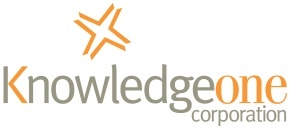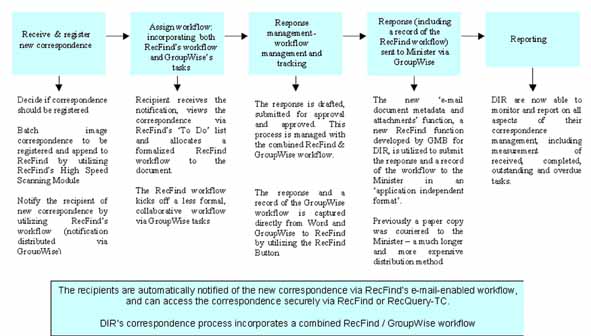
Case Studies |
Managing Ministerial Correspondence in a ‘paperless’ environment at NSW Department of Industrial Relations (DIR)DIR Overview DIR’s charter is to administer a number of New South Wales statutes, the most
significant of which is the Industrial Relations Act 1996. DIR’s vision is statewide compliance with the NSW industrial framework in an environment that is equitable and which promotes workplace reform. DIR’s mission is to work with employees, employers and their representatives to facilitate equitable, innovative and productive workplace relations. Electronic Document Management System (EDMS) Project Effective management of information is critical to DIR – in particular ministerial correspondence. It is essential to DIR that DIR’s employees create, manage and track paper and electronic corporate records and documents that are:
Recognizing that their information management effectiveness and efficiency was limited by their existing paper-based workflow processes, DIR asked Knowledgeone Corporation to undertake a review of DIR’s information management procedures DIR had utilized RecFind for records management since 1997, however prior to the EDMS project RecFind’s use was limited to managing historical records only. For example, a ministerial correspondence document received would be registered, and the workflow process managed, in a number of disparate registers and systems prior to be registered to RecFind at the conclusion of the workflow process. Issues identified by DIR employees with the paper based processes utilized prior to the EDMS project included:
To resolve these issues it was recommended to implement a ‘paperless’ workflow process by expanding the use of RecFind to encompass imaging, electronic document management and workflow, and widen RecFind’s application use to include correspondence management, in addition to its use for records management. The new information management processes implemented included:
The EDMS project had the following objectives:
The DIR EDM Project Manager Richard Hayes felt the main obstacle to a successful implementation to overcome was the cultural change – employees were accustomed to paper processes. Richard overcame this obstacle by utilizing GroupWise in conjunction with RecFind for the new workflow process. “Everyone was very familiar and comfortable with GroupWise so the change to incorporate the new RecFind / GroupWise workflow was minor and the implementation was surprisingly smooth”. An overview of the new DIR Ministerial Correspondence ‘paperless’ workflow process is depicted in the following flow chart:
Post-implementation Significant benefits achieved for DIR via the EDMS implementation have included:
Key reasons for a successful EDMS project at DIR
|
